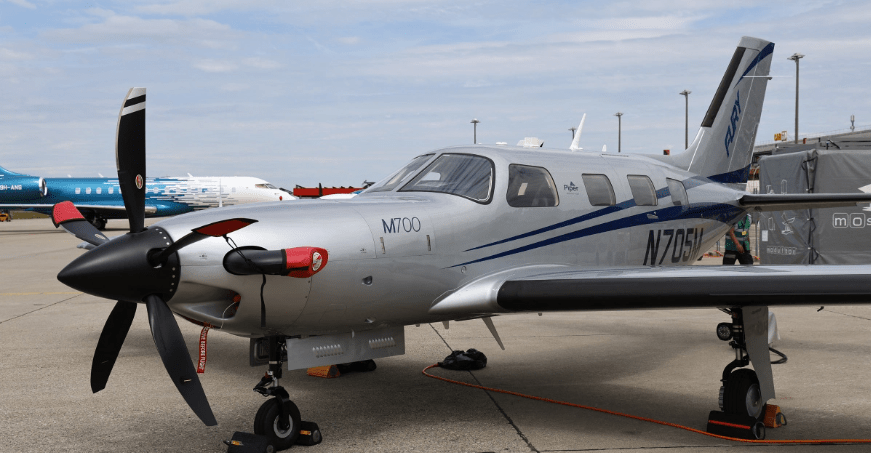Aviation News – After flying Piper Aircraft’s new turboprop-single M700 Fury, it’s clear that this is the airplane that customers have been waiting for. A larger engine with 100 more shaft horsepower boosts performance, yet it’s still possible to fly as efficiently as the previous model, the M600 SLS. EBACE 2024 attendees can see the $4.1 million M700 at the static display.
I flew the M700 last week with Piper manager of engineering flight test Joel Glunt at Piper’s Vero Beach, Florida headquarters. Coincidentally, Piper had just received FAA flight into known icing approval for the airplane. The remaining certification item is unpaved runway approval, which is expected shortly.
The main difference between the M600 and M700 is the latter’s Pratt & Whitney Canada PT6A-52 engine and five-blade composite Hartzell propeller, the latter of which was optional on the M600. To accommodate the more powerful engine, the M700’s intake plenum was redesigned for improved ram air recovery and the exhaust stacks have a flatter design that maximizes residual thrust.
There are no changes to the airframe and equipment; both have six seats and Garmin touchscreen-controlled G3000 avionics with autothrottle and Autoland. The M700 adds Garmin’s PlaneSync 4G LTE cellular datalink, which allows owners to check fuel quantity, aircraft location, oil temperature, battery voltage, and Metar weather report at the M700’s location and download databases wirelessly and remotely.
Its more powerful engine delivers better performance during climb and at high altitude, and significant improvements in takeoff and landing distance. At the 6,000-pound maximum takeoff weight, climb rate is 2,048 fpm, a 32% improvement over the M600. Climb to FL250 takes 13.9 minutes, a 34% improvement.
The M700’s takeoff distance is 1,994 feet and landing distance is 1,968 feet, compared with the M600’s 2,635 and 2,659, respectively. Landing performance is without prop reverse, just using beta mode.
Its empty weight is 80 pounds greater than the M600 because of the larger engine, so payload with maximum fuel of 260 gallons is 565 pounds versus the M600’s 658 pounds. But the extra power boosts the maximum range to 1,852 nm, up from 1,658 nm for the M600. What owners will like most is the higher maximum cruise speed of 301 ktas, 27 knots faster than the M600.
Glunt reminded me before taking off from Vero Beach’s Runway 12R that while the M700 has an autothrottle, the engine isn’t digitally controlled, so the pilot needs to advance the power just enough—to about 800 foot-pound of torque—for the autothrottle to engage and not advance the throttle all the way.
The 700-shp PT6 accelerated the M700 rapidly to the 75-knot rotation speed, and I pulled the nose up and then up and up some more, trying to keep to the 95-knot best rate of climb speed. we were loaded with 1,055 pounds of fuel, not quite two-thirds of the max fuel capacity, and our takeoff weight was just under 5,400 pounds. Initial climb rate was well over 3,000 fpm as we headed up to 13,500 feet, and even through 8,000 feet we climbed at 2,500 fpm.
After leveling off at 13,500 feet, I reacquainted myself with the handling of Piper’s M-class turboprops. I’ve always enjoyed flying the M500 and M600, and the Fury carries on the familiar Piper feel. Having learned to fly in Pipers, the M-class airplanes feel just like larger Cherokees, with crisp response although the pitch control is heavier due to the size and weight of the airplane. Pitch trim is definitely helpful.
Glunt demonstrated some of the M700’s Garmin Electronic Stability & Protection (ESP) envelope protection features. We switched ESP off so I could do some steep 180-degree turns without the nudge to wings level protection, and these were easy to do by keeping the primary flight display (PFD) flight path marker on the horizon line. Banks at 30 degrees were so smooth it felt like the airplane was on rails. Stalls were benign, with no wing drop and a simple reduction in angle of attack and adding power to recover.
With the autopilot on, I steered the M700 back to Vero Beach for a coupled RNAV approach to Runway 12R. With approach mode selected, the autothrottle perfectly set the speed as the autopilot tracked the glide path to the runway. I watched the PFD as the M700 aligned with the runway, illustrated by centerline chevrons with mile markers leading to the runway end.
At 200 feet, I clicked off the autopilot and, heeding Glunt’s reminder that the rudders and nosewheel are directly connected, straightened the rudder pedals just before touchdown in the gusty left crosswind. Pulling the power lever into beta mode slowed the Fury nicely for the turnoff.

